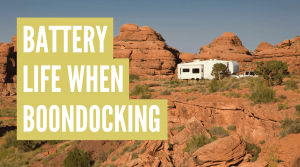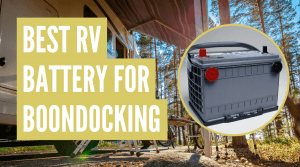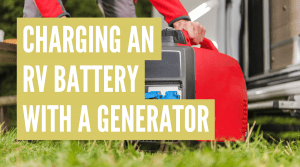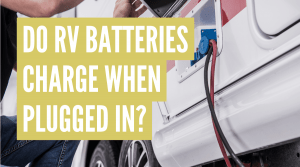Camper FAQs is reader-supported. Buying through links on our site may earn us an affiliate commission. As an Amazon Associate I earn from qualifying purchases.
The sun is a free and abundant source of energy. It can power homes, offices, and even your RV!
This convenient energy source allows you to charge your RV batteries and power your electrical devices without a generator and in spots where shore power isn’t an option (think boondocking).
And adding solar panels to your recreational vehicle is much easier than you might have thought.
This step-by-step guide will show you exactly how to hook up solar panels to RV batteries and charge them anywhere your next adventure takes you!
What Size Solar Panel Do I Need to Charge My RV Battery?
Before we jump into how to hook up solar panels to your RV batteries, let’s first quickly calculate the size of the solar panel(s) you’ll need to charge your batteries and power the accessories and appliances in your RV.
I like to keep things as simple as possible. In most cases, a 200 to 400-watt solar panel setup will be enough to charge your RV batteries, providing there is direct sunlight.
At the bottom end of the range, a 200-watt system should be sufficient for very basic power needs – lights, fans, propane appliance electronics, phone chargers, etc. Now, let’s throw in a television, microwave, and other higher-power electrical items, and you’ll likely need closer to 400 watts (or more).
There are many solar calculators online to help you figure out your solar wattage requirements, but there are so many variables at play that they are just guesses at best. Essentially, the calculators try to match the electric power requirements of your recreational vehicle with the power output of your solar cells.
But the only accurate way to tell is to test out your system in the wild. And if you’ve laid the proper groundwork for your solar power setup (which we show you how step-by-step below), you’ll be able to quickly expand your system with additional solar panels if needed.
How to Hook up Solar Panels to Your RV Batteries Step-by-Step
Hooking up solar panels to your RV batteries is a straightforward process: Your solar panels sit outside your RV soaking up the sun’s energy, wires carry that energy to the charge controller in your RV, and wires connect the charge controller to your RV batteries, charging them.
But wait, why can’t you connect a solar panel directly to the battery (or bank of batteries)? That might work if the solar panel is extremely low wattage (5 watts or less), but it’s not recommended. You will want to use a battery charge controller to safely charge your camper battery for optimal performance and lifespan.
Now, we’ll first need a few supplies to install solar panels.
What You’ll Need
- Solar Panel(s) – at least 200 to 300 watts (you can wire multiple 100w solar panels in parallel)
- Solar Charge Controller
- 10AWG Solar Panel Connectors Adaptor Kit
- 10AWG Tray Cable
- 12v battery (If needed. We like this Renogy deep-cycle, 100 amp hours battery)
- Optional: Mounting brackets
- Optional: Inverter (DC to AC power inverter to power your 120-volt AC appliances)
I highly recommend using the Renogy Complete RV Solar System Kit that comes with everything you need (minus the RV battery and optional inverter) to get your solar charging system up and running! Renogy has put together one of the highest-rated off-grid RV solar systems on the market today.
Tip: To get the most out of your solar energy system, you’ll need a high-quality battery! Check out our picks for the best RV battery for boondocking to find the right battery for you and your camping needs.
Installation Instructions

- Connect the battery to the charge controller using the tray cable. The red wire goes into the positive port, and the green wire goes into the negative port of the charge controller. Tighten the screw connections. Then connect the other end of the tray cable to the battery (red connects to the positive terminal, green to the negative). Important: Be sure you do this step first so as not to cause irreversible damage to your solar system components!
- Connect the solar panel MC4 female connector to the adaptor kit’s MC4 male connector. Then, connect the solar panel’s MC4 male connector to the adaptor kit’s MC4 female connector.
- Connect the negative solar panel line to the negative solar terminal of the charge controller. Then, connect the positive solar panel line to the positive solar terminal of the charge controller. You may have to strip the ends of the wires 3/8″ to connect them to the charge controller. Tighten the screws on the charge controller to ensure a tight connection.
- Optional: Once everything is properly hooked up, we can now connect the inverter by first connecting the negative battery terminal to the negative port of the power inverter. Then, connect the positive battery terminal to the positive port of the power inverter.
Are you more of a visual learner? Check out this video for a step-by-step breakdown to hook up solar panels to your RV batteries.
Important: Be sure to read and follow the directions with your specific solar panel kit, as each kit may have different installation instructions and requirements.
One last consideration is where you plan to put your RV solar panels. You have a few different options:
- RV Roof-mounted: Using the optional mounting kit, you can attach your solar panels to the roof of your RV, travel trailer, or camper van and use a cable entry plate to run the wires down into the rig.
- Manual setup: Alternatively, you can manually set up and plug in your solar panels outside whenever you want to use them. Then pack them up and store them when not in use. If you go this route, remember your charge controller needs to be mounted inside your RV, out of the weather. One option is to mount the charge controller in an easily accessible storage bay close to your RV batteries, if possible.
That’s all there is to hook up your portable solar energy system! And don’t forget, you can make the DIY process a lot easier by using the Renogy RV Solar Panel Kit, one of the best solar panel systems for RV battery charging we’ve worked with.







Write a comment